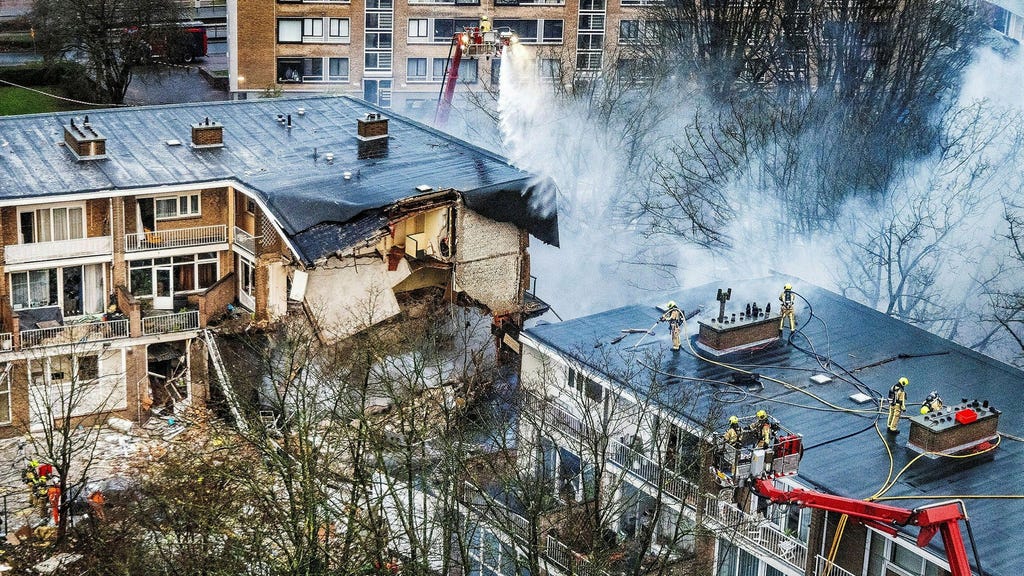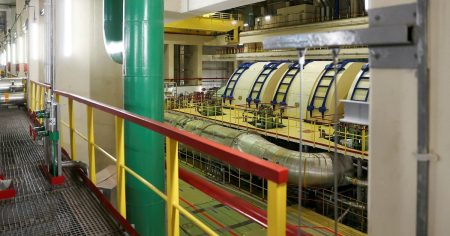A devastating explosion ripped through a three-story apartment building in The Hague, Netherlands, on a Saturday morning, reducing much of the structure to rubble. The blast occurred around 6:15 am in the Mariahoeve district, a northern suburb of the city. Emergency services, including firefighters and search and rescue teams with sniffer dogs, rushed to the scene. Images from Dutch media outlets showed the extent of the damage, with the building partially collapsed and firefighters battling flames amidst the debris. Four individuals were rescued and transported to hospitals, though the severity of their injuries remained unknown in the immediate aftermath. The Haaglanden Veilig fire department clarified that the explosion primarily affected five residences across two floors, correcting earlier reports that suggested a wider impact.
The explosion’s impact reverberated through the neighborhood, shattering windows and blackening facades with soot. The street was strewn with a chaotic mix of wood, glass, stone, metal, and other debris, painting a stark picture of the blast’s destructive force. Eyewitnesses recounted the terrifying moments, describing the sound as akin to a bomb. One resident, who had lived in the area for eight years, told De Telegraaf that they had never heard anything like it before, initially underestimating the scale of the devastation. Another neighbor, speaking to Algemeene Dagblad, reported hearing three distinct explosions – one originating from a car that subsequently caught fire, followed by two more from the vicinity of the apartment building.
The apartment building housed a mix of elderly residents and families with children, according to the ANP news agency. Around 40 apartments were evacuated as a precautionary measure. The rescue operation involved a significant mobilization of resources, with emergency services even resorting to felling trees to facilitate their work. Police deployed helicopters and drones to survey the area from above, while forensic teams commenced their investigation into the cause of the explosion.
The explosion sent shockwaves through the nation, drawing immediate reactions from high-ranking officials. Dutch Prime Minister Dick Schoof expressed his shock and dismay at the ”terrible images” emerging from The Hague, the country’s administrative capital. He pledged full support to Mayor Jan van Zanen, who visited the site shortly after the explosion to assess the situation firsthand. The incident underscored the vulnerability of residential areas to such catastrophic events, prompting immediate concern and support from the highest levels of government.
The immediate focus remained on rescuing any remaining survivors trapped within the rubble and providing medical attention to the injured. The investigation into the cause of the explosion was in its early stages. The scale of the destruction and the impact on the affected families and the wider community were significant. The explosion served as a stark reminder of the unpredictable nature of such disasters and the importance of preparedness and effective emergency response.
The incident in The Hague highlighted the challenges faced by emergency services in responding to sudden and large-scale disasters. The complexity of the rescue operation, involving multiple agencies and specialized equipment, underscored the importance of coordinated efforts and effective communication. The aftermath of the explosion will likely involve a thorough investigation to determine the exact cause and to identify any potential preventative measures that could mitigate the risk of similar incidents occurring in the future. The focus will also shift towards supporting the affected families, providing them with temporary housing, and assisting them in rebuilding their lives. The long-term impact of the explosion on the community, both physically and psychologically, will require ongoing support and resources.














